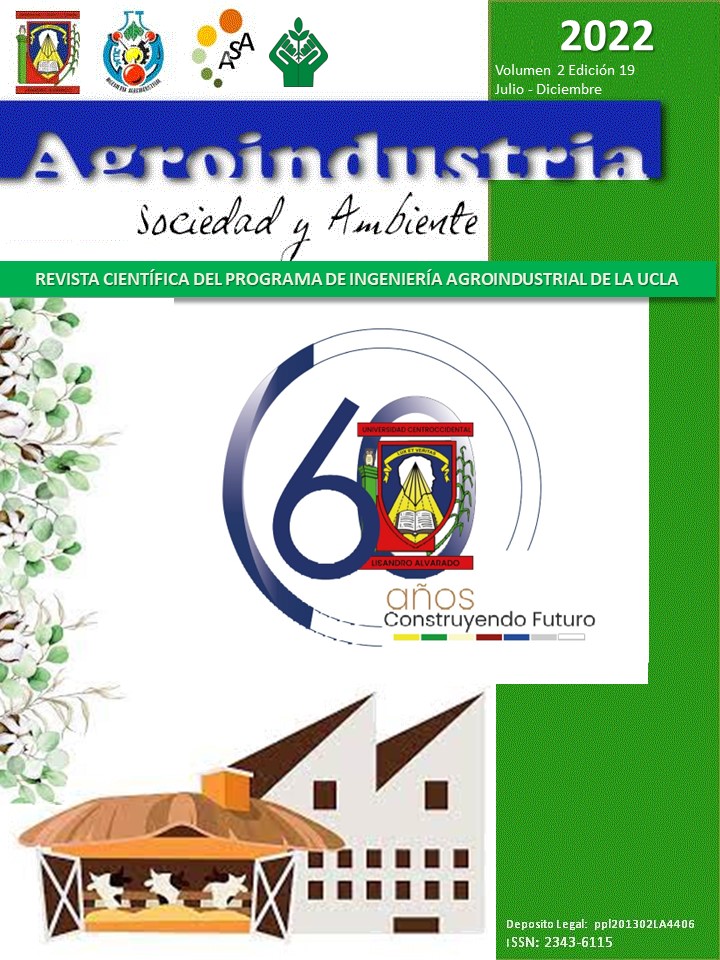Evaluación de un sistema de aprovechamiento del gas metano como combustible para calderas en una destilería
DOI:
https://doi.org/10.5281/zenodo.7365058Palabras clave:
Biogás, caldera, digestión anaeróbica, metano, vinaza.Resumen
En el presente trabajo se evaluó un sistema de aprovechamiento del gas metano (SAGM) generado en el proceso de digestión anaeróbica de la vinaza. El biogás se desea utilizar como combustible en calderas de la empresa Destilerías Unidas S.A. (DUSA). Se empleó la investigación explicativa y diseño experimental. El SAGM fue diseñado a escala de laboratorio, estuvo conformado por un reactor anaeróbico para el tratamiento de la vinaza con volumen útil de 6 L, una columna de adsorción sólido-gas rellena con epicarpio de Cocos nucifera (concha de coco) y por una columna de absorción líquido-gas con solución de óxido de calcio (cal). La eficiencia de las columnas fue evaluada individualmente para conocer su efecto en la remoción de H2S y CO2, como los principales contaminantes del biogás al ser usado como combustible de motores fijos. Inicialmente se realizó la caracterización del biogás determinando la concentración de H2S y CO2 por métodos volumétricos, posteriormente se evaluó la eficiencia de remoción de cada uno de los gases al pasarlo por el S.A.G.M. Se obtuvo que el biogás contenía 4,89 mg/L de H2S y 296,03 mg/L de CO2. El sistema de purificación fue más efectivo para la remoción del CO2, lográndose eficiencias de 95,78 y 98,16% al utilizar la columna de absorción y adsorción, respectivamente. El H2S no fue removido significativamente de acuerdo a la prueba de hipótesis con un nivel de confianza del 99%, debido al bajo contenido inicial de este gas, la menor afinidad y velocidad de reacción de los sulfuros cuando está presente el CO2. Se concluyó que el biogás purificado en el S.A.G.M. puede ser usado como combustible en las calderas de la empresa, porque el CO2 remanente es despreciable y la concentración H2S está por debajo de los límites recomendados para alimentar un motor estacionario.
Descargas
Citas
APHA-AWWA-WEF AMERICAN PUBLIC HEALTH ASSOCIATION. (2005). Stándar Methods for the Examination of Water and Wastewater. (21th. ed.). Whashintong D.C. Estados Unidos.
Bosch, R. (2005). Manual del automóvil. (4ª. ed.). Alemania: Karl-Heinz Dietsche, p. 550-551.
Castells, X. (2012). Tratamiento y valorización energética de residuos. Madrid: Díaz de Santos, p. 606,755-756.
Conil, P. (2000). El aprovechamiento del biogás de las lagunas de estabilización: perfil del proyecto "Palmeiras" en Tumaco (Colombia). [Artículo en línea]. Disponible: publicaciones.fedepalma.org Consulta: 2022, julio 15.
Elías, X. (2012). Reciclaje de residuos industriales. Residuos sólidos urbanos y fangos de depuradoras. (2ª. ed.). Madrid: Díaz de Santos, p. 18.
Fernández, M. (2003). Aprovechamiento del biogás producido en la planta de tratamientos de Destilerías Unidad S.A. [Informe de Pasantías]. Universidad Experimental Politécnica “Antonio José de Sucre”, Vicerrectorado Barquisimeto, Venezuela.
Garrido, N., Navarro, H. Díaz, Manuel. Y Pérez, I. (2010). Evaluación de alternativas de producción de levadura forrajera a partir de vinazas mediante simulación Super Pro Designer. Red de Revistas Científicas de América Latina y el Caribe. Disponible: http://www.redalyc.org Consulta: 2022, julio 15.
Larrahondo, J., Morales, A., Victoria, H. (2000). Compuestos orgánicos en vinaza. Carta Trimestral. Cenicaña, 22 (3). Disponible: http://www.cenicana.org Consulta: 2022, julio 15.
Llaneza, H.; Morís, M.; González. L (2010). Estudio de viabilidad de sistemas de purificación y aprovechamiento de biogás. PSE PROBIOGAS. Desarrollo de sistemas sostenibles de producción y uso de biogás agroindustrial en España.
Lelieveld, J., Crutzen, P. y Brühl, C. (1993). Climate effects of atmospheric methane. Chemosphere, 26 (4).
Metcalf & Eddy. (1996). Ingeniería de aguas residuales. Tratamiento, vertido y Reutilización. (Tomo1). México: McGraw – Hill, p. 480 y 484.
Montalvo, S. y Guerrero, L. (2003). Tratamiento anaerobio de residuos. Producción de biogás. Chile: Universidad Técnica Federico Santa María, p. 383-384, 387, 391, 393, 400, 402-405.
NORMA VENEZOLANA COVENIN 3340. (1997). Bebidas alcohólicas.
NORMA VENEZOLANA COVENIN- ISO 14001. (2002). Sistema de gestión ambiental especificación para su uso.
Normativa Ambiental Venezolana. Decreto N° 883 (1995). Gaceta Oficial de la República de Venezuela, 5.021 (Extraordinaria), 18-12-1995.
Rudolph, M. (2005). Química orgánica simplificada. España: Reverté, p. 61 – 62.
Sabino, C. (1992). Recirculación de vinazas tequileras en la fermentación alcohólica. [Tesis en línea]. Universidad de Guadalajara, México. Disponible: http://biblioteca.cucba.udg Consulta: 2022, julio 15.
Subiros, F. (2000). El cultivo de la caña de azúcar. Costa Rica: EUNED, p. 362-363.
Walpole, R.; Myers, R; Myers, S. y Ye, K. (2012). Probabilidad y estadística para ingeniería y ciencias. (9na. Ed.). Pearson Educación: México.
Publicado
Cómo citar
Número
Sección
Derechos de autor 2022 Franklin Rafael Gómez Hernández

Está obra está bajo licencia Creative Commons Attribution-NonCommercial-ShareAlike 4.0 International License.
Derechos del/de autor/es a partir del año de publicación
Esta obra está bajo la licencia:
Creative Commons Reconocimiento-NoComercial-CompartirIgual 4.0 Internacional (CC BY-NC-SA 4.0)
Las opiniones expresadas por los autores no necesariamente reflejan la postura del editor de la publicación ni de la UCLA. Se autoriza la reproducción total o parcial de los textos aquí publicados, siempre y cuando se cite la fuente completa y la dirección electrónica de esta revista. Los autores(as) tienen el derecho de utilizar sus artículos para cualquier propósito siempre y cuando se realice sin fines de lucro. Los autores(as) pueden publicar en internet o cualquier otro medio la versión final aprobada de su trabajo, luego que esta ha sido publicada en esta revista.




